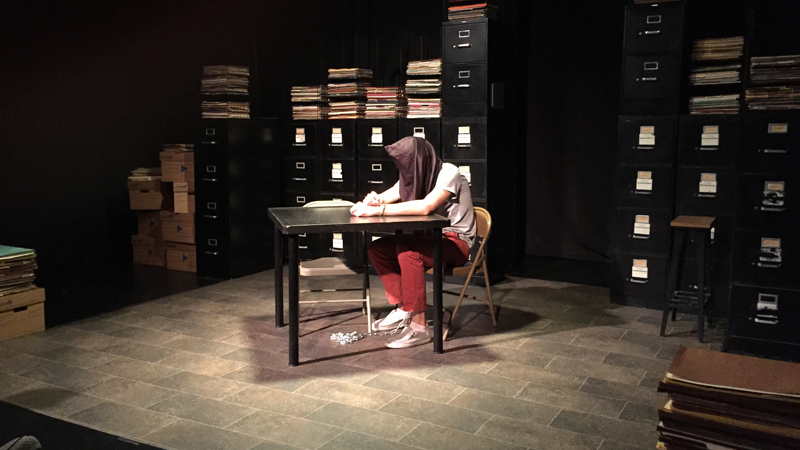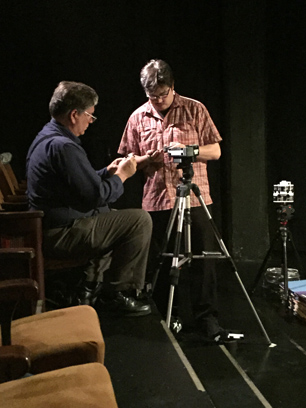We walked quickly through the all-too-real world of San Francisco's Tenderloin district to see first-hand what was touted as the first theatrical play to premier live on stage and in virtual reality (VR) at the same time. Stepping around limp bodies, past street-side transactions, and over sundry detritus, we made our way deeper and deeper into the belly of the beast.
The destination, a restaurant and club called Pianofight, could not have contrasted more with the world outside, with its milk-white tech worker clientele, portobello mushroom burgers, assorted microbrews, and the lamest of 70s light rock. Further inside, we were handed Google Cardboard (TM) viewers and ushered through a door leading to a small black-box theatre. On stage surrounded by filing cabinets and stacks of paper files sat a lone man: shackled and hooded.
 The scene that greets patrons as they enter the theatre to see Don't Be Evil.
The scene that greets patrons as they enter the theatre to see Don't Be Evil. This was the prelude to the Department of Badassery's production of Bennett Fisher's new play Don't Be Evil, which without even bothering to smack of irony, is also the infamous corporate motto of Google (makers of said Cardboard). The plot centered around a Silicon Valley software genius (played by Justin Liszanckie) who has engineered a new search engine that provides answers so well researched that it caused the government enough concern to resort to certain questionable measures.
The unsettling result comes across as something akin to a Kafka interpretation of Waiting for Godot (perhaps with the prisoner as the tree?), wrapped around the parable of Jonah and the whale. Taking place in an underground labyrinth of identically stark offices, a hapless pair of investigators (Daria Johnson and Eric Reid*) interrogate their captive in a futile attempt to find the answers they seek, while higher level questions circulate about he nature of good and evil and who here is truly the captive of whom?
Deep in this abyss where the investigators are free to practice their trade in hidden isolation away from the public eye, it is not lost on the audience that at the foot of the stage there are not one but two 360 VR cameras capturing in their entirety the acted scenes as well as the audience itself. The virtual reality production studio, CloserVR, set up their custom gear to capture the world premiere of this new play. But is this equipment merely an instrument of documentation? ...or in the larger context, does it become commentary on the story itself?

The cameras are designed to record live action for later presentation within an immersive VR viewer (like the Cardboard). These viewers, like the hood over the prisoner's head, work by visually isolating one from the outside world: the former with sensory replacement, the latter with sensory deprivation (the anti-VR). The cameras, physically present in this theatre, record the action presented on stage; but later when someone views the recorded work as "cinematic VR", the stage is then in the headset display. Who is watching whom? Did the whale swallow Jonah, or the other way around?
Don't Be Evil runs from September 11 - October 3 at PianoFight in San Francisco. Get TICKETS HERE.
Information about the VR film, including the viewable output are to be available HERE.
Laura Kusumoto contributed to this article.
*Editors note: in a previous version of this article, an actor playing one of the two investigators was mistakenly identified as Steven Cloyes, when in fact that character was played by Eric Reid. Mr. Cloyes was actually cast in the role of Murdock who, for all we know, was also Godot.

